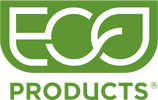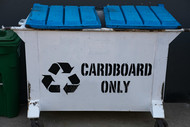From Trash to Treasure: A Look at the History of Recycling and the Chasing Arrows Symbol
Posted by Eco-Products on May 15th 2025
If you’ve ever tossed a container into the recycling bin, chances are you saw the familiar triangle made of three arrows. That symbol—often called the “chasing arrows”—is one of the most recognized icons in the world. But have you ever stopped to ask where it came from or what it means?
Recycling as a practice has been around for a long time—centuries, in fact—but the modern recycling movement, and the symbol that came with it, has a surprisingly recent origin story. And as sustainability conversations continue to evolve, so too does the meaning and relevance of this simple design.
Let’s take a closer look at how the chasing arrows symbol came to be, what it was originally intended to convey, and why understanding its history matters more than ever today.
Key Takeaways
- The chasing arrows symbol was created by a college student in 1970 during a design contest held in honor of the first Earth Day.
- Its meaning has been widely misunderstood and sometimes misused, contributing to confusion around what’s actually recyclable.
- Recycling has ancient roots, but the modern system developed rapidly during and after major industrial and wartime periods.
- Today’s recycling symbols often lack standardized definitions, and not all packaging marked with arrows is recyclable.
- Compostable packaging offers a clearer, more responsible end-of-life path—especially for foodservice items.
The Origins of the Chasing Arrows
The story of the chasing arrows symbol starts in 1970, the same year as the first Earth Day. A container company called Container Corporation of America held a design competition for students to create a symbol that could represent recycled paper. The winner? A 23-year-old college student named Gary Anderson.
Anderson’s design featured three folded arrows that bent back on themselves in a loop, inspired in part by the Möbius strip—a shape with only one side and one edge. Each arrow represented one stage of the recycling process: collection, processing, and reuse.
The simplicity of the design helped it take off. It quickly became synonymous with recycling in general, not just paper. But that widespread adoption came with a tradeoff: the meaning of the symbol started to blur.
Recycling’s Deeper Roots
Of course, the concept of recycling predates the 1970s by a long shot. Humans have been reusing materials out of necessity for centuries. Archeologists have found evidence of glass recycling in the Roman Empire. In the U.S., during World War II, metal, rubber, and even cooking fats were collected and repurposed for the war effort.
In the decades that followed, the rise of single-use packaging and consumer culture made recycling feel like a modern solution to a modern problem. Municipal recycling programs began to scale in the 1980s and 1990s, with the chasing arrows symbol acting as a sort of green seal of approval—even when it wasn’t always accurate.
Not All Arrows Are Created Equal
Here’s where things get tricky: many people assume the chasing arrows symbol means something is recyclable. In reality, that’s not always the case.
In the 1980s, a resin identification code system was developed to help recycling facilities distinguish different types of plastic. These codes (numbers 1–7) were placed inside the chasing arrows. But the presence of the symbol led many people to believe these plastics were universally recyclable—which wasn’t true then, and still isn’t now.
In fact, only certain types of plastic (typically #1 and #2) are widely accepted by most recycling programs. The others? They often end up in landfills or incinerators due to contamination, lack of demand, or lack of processing infrastructure.
This disconnect between what consumers believe and what actually gets recycled is known as Hopeful Recycling—the hopeful but misguided act of tossing something into the bin because it “seems recyclable.” Unfortunately, Hopeful Recycling can contaminate recycling streams and cause more harm than good.
The Rise of Compostable Packaging
As awareness of these challenges has grown, so has the push for more environmentally preferable alternatives—especially in foodservice, where contamination from oils and food scraps can make packaging unrecyclable.
That’s where compostable packaging comes in. Products made from renewable resources—like plant-based plastics (PLA) and sugarcane—bamboo can be processed in commercial composting facilities alongside food waste. This helps divert waste from landfills and supports soil health in the process.
At Eco-Products®, we design packaging specifically for this purpose. Our items are clearly labeled, BPI-certified compostable, and built to support a circular economy. Unlike the vague implications of a chasing arrows symbol, compostable certifications offer a clear, science-backed promise: this product will break down in a properly managed compost environment.
Rethinking the Symbols We Trust
The chasing arrows symbol has played a big role in raising awareness about recycling. But like any tool, it’s only as useful as our understanding of it. As we look to a future built around Zero Waste goals and circular systems, it's time to evolve beyond outdated assumptions.
Better education, clearer labeling, and smarter materials can help close the gap between intention and impact. Whether you’re a sustainability manager at a stadium or someone ordering takeout at home, knowing the difference between recyclable, compostable, and Hopeful Recycled iIsRecycledis essential.
Ready to Put Waste to Work?
At Eco-Products, we believe there’s potential in every plate, cup, and container—especially at the end of the meal. By choosing compostable solutions and supporting better infrastructure, we can move from confusion to clarity, and from symbols to systems that actually work.
Want to learn more about how we’re building a better foodservice future? Explore our compostable product lines or dig into our Zero Waste resources.

